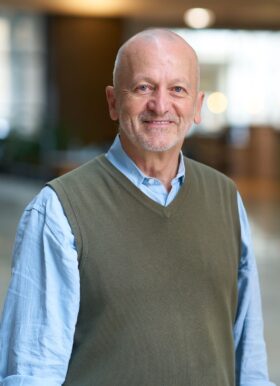
Taghert Lab | Google Scholar Profile | ResearchGate Profile | Neurotree
Research
The Taghert laboratory seeks to understand the organization, regulation and outputs of circadian neural circuits in the Drosophila brain.
The laboratory is taking advantage of the remarkable molecular genetic methods that are available with this model system. The lab’s principal contributions include identifying roles played by the PDF neuropeptide and its receptor. The lab has analyzed its role genetically, demonstrated it to be a synchronizer of the molecular clock in individual pacemaker neurons under constant conditions.
More recently, in collaboration Tim Holy’s lab, the lab has employed novel imaging techniques to perform brain-wide scanning in real-time in vivo across the entire day (Liang et al., 2016 Science). Each pacemaker group has its own specific phase of activity (in contrast to the phases of their clocks, which are synchronous). Unexpectedly, PDF signaling is critical to delay Evening Oscillator activity ~8 hr following the dawn, and so generate its distinct Evening Oscillator activity phase.
The laboratory is currently expanding the scope of their imaging studies to determine in vivo realtime 24 patterns of changes in voltage and cyclic nucleotides in this pacemaker network. In addition, we have found that PDF sensitivity cycles across the day (Klose et al., 2016 Neuron) – with greatest sensitivity around dawn – and have shown this cycle critically defines the time of neuropeptide modulation. Many of the lab’s current studies use genetics, imaging, and biochemistry to pursue the molecular basis for signaling downstream of the PDF receptor.
Selected publications
- Liang X, Ho MC, Zhang Y, Li Y, Wu MN, Holy TE, Taghert PH. Morning and evening circadian pacemakers independently drive central complex premotor centers via a specific dopamine relay. Neuron. 2019; 102(4):843-57 e4. Epub 2019/04/15.
- Liang X, Holy TE, Taghert PH. A series of suppressive signals within the Drosophila circadian neural circuit generates sequential daily outputs. Neuron. 2017 June 21; 94(6):1173-1189.
- Liang X, Holy TE, Taghert PH. Synchronous Drosophila circadian pacemakers display non-synchronous Ca2+ rhythms in vivo. Science. 2016; 351:976-981.
- Klose M, Duvall L, Li W, Liang X, Ren C, Steinbach JH, Taghert PH. Functional Pdf signaling in the Drosophila circadian neural circuit is gated by Ral A-dependent modulation. Neuron. 2016; 90(4):781-794. doi: 10.1016/j.neuron.2016.04.002.
- Park D, Li P, Dani A, Taghert PH. Peptidergic cell-specific synaptotagmins in Drosophila: Localization to dense-core granules and regulation by the bHLH protein DIMMED. J Neurosci. 2014; 34(39):13195-13207.
- Duvall LB, Taghert PH. The circadian neuropeptide PDF signals preferentially through a specific adenylate cyclase isoform AC3 in M pacemakers of Drosophila. PLoS Biology. 2012; 10(6):e1001337.
- Shafer OT, Kim DJ, Dunbar-Yaffe R, Nicholaev V, Lohse M, Taghert PH. Widespread receptivity to neuropeptide PDF throughout the circadian clock network of Drosophila revealed by realtime cAMP imaging. Neuron. 2008; 58:223-237.
- Mertens I, Vandingenen A, Johnson EC, Shafer OT, Li W, Trigg JS, De Loof A, Schoofs L, Taghert PH. PDF receptor signaling in Drosophila contributes to both circadian and geotactic behaviors. Neuron. 2005; 48:213-219.
- Lin Y, Han M, Shimada B, Wang L, Gibler TM Amaorone A, Awad T, Stormo GD, Van Gelder RN, Taghert PH. Influence of the period-dependent circadian clock on diurnal, circadian, and aperiodic gene expression in Drosophila melanogaster. Proc. Nat. Acad. Sci USA. 2002; 99:9562-9567.
- Renn SCP, Park J, Rosbash M, Hall JC, Taghert PH. A pdf neuropeptide gene mutation and ablation of PDF-containing neurons each cause severe abnormalities of circadian behavioral rhythms in Drosophila. Cell. 1999; 99:791-802.
See a complete list of Dr. Taghert’s publications on PubMed.
Education
- 1975 BA, Biology, Reed College, Portland, OR
- 1981 PhD, Zoology, University of Washington, Seattle, WA (Advisor: James W. Truman)
- 1981-1984 Postdoctoral Fellow, Stanford University, Stanford, CA (Advisor: Corey S. Goodman)
Selected honors
- 2020 AAAS Fellow
- 1985-1987 Sloan Foundation Fellowship
- 1983-1984 NIH Post-Doctoral Fellowship
- 1981-1982 Muscular Dystrophy Association Fellowship
- 1980 NIH Graduate Trainee
- 1976-1979 NSF Pre-Doctoral Fellowship
- 1975 Class of 1921 Prize, Reed College